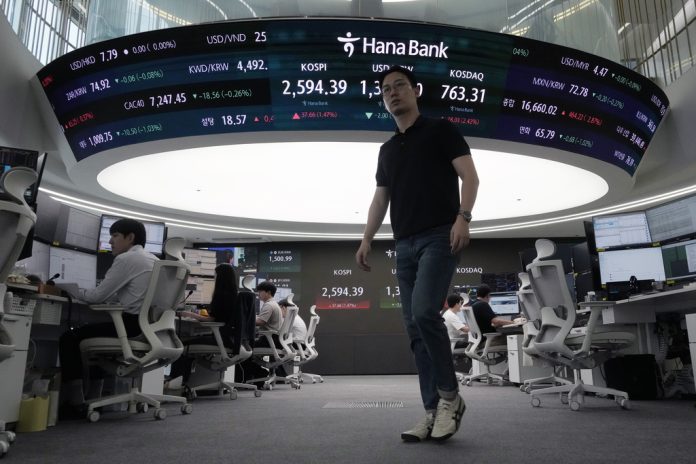Asian stocks were higher Friday after U.S. stocks rallied Thursday in Wall Street’s latest sharp swerve after a better-than-expected report on unemployment eased worries about the slowing economy.
U.S. futures and oil prices rose.
In Tokyo, the Nikkei 225 index was up 1.6% at 35,380.23. The yen again fell under pressure after three days of rising against the dollar, giving a lift to Japanese stocks that often rise when the yen falls.
Earlier this week, weaker-than-expected employment data from the U.S. raised concerns about a slowing economy where the Federal Reserve has kept the high interest rates that aim to stifle inflation for too long. That tipped off a sell-off in global markets, with the scale of the declines amplified as investors unwound their yen carry trade positions.
On early Friday trading, the U.S. dollar rose to 147.15 Japanese yen from 147.24 yen. The euro cost $1.0924, up from $1.0918.
China’s inflation came in higher than expected in July, with the consumer price index rising 0.5% compared to the same period a year earlier, boosted by food prices which are no longer dragging on inflation and were flat last month.
The Hang Seng in Hong Kong added 1.9% to 17,211.26 and the Shanghai Composite index edged 0.2% higher to 2,876.51.
In South Korea, the Kospi jumped 1.5% to 2,595.50, Australia’s S&P/ASX 200 advanced 1.4% to 7,792.80.
Elsewhere, Taiwan’s Taiex gained 3.4%, with chip maker Taiwan Semiconductor Manufacturing Co. gaining 3.6%, tracking Big Tech stocks’ rally on Wall Street. The SET in Bangkok was up 0.5%.
On Thursday, the S&P 500 jumped 2.3% to 5,319.31, for its best day since 2022 and shaved off all but 0.5% of its loss from what was a brutal start to the week. The Dow Jones Industrial Average rose 1.8% to 39,446.49, and the Nasdaq composite climbed 2.9% to 16,660.02 as Nvidia and other Big Tech stocks helped lead the way.
Treasury yields also climbed, signaling that investors are feeling calmer about the economy after a report showed fewer U.S. workers applied for unemployment benefits last week. The number was better than economists expected.
So far, the S&P 500 is still down nearly 10% from its all-time high set last month. Such drops are regular occurrences on Wall Street, and “corrections” of 10% happen roughly every year or two. After Thursday’s jump, the index is within about 6% of its record.
Still, the market’s swings look more like a “positioning-driven crash” caused by too many investors piling into similar trades and then exiting them together, rather than the start of a long-term downward market caused by a recession, according to strategists at BNP Paribas.
They say it looks more similar to the “flash crash” of 2010 than the 2008 global financial crisis or the 2020 recession caused by the pandemic.
In the meantime, big U.S. companies continue to turn in profit reports for the spring that are mostly better than analysts expected.
Eli Lilly jumped 9.5% to help lead the market after it delivered stronger profit and revenue than Wall Street had forecast. Sales of its Mounjaro diabetes treatment and its Zepbound weight-loss counterpart are booming, and the company raised its financial forecast for the year.
In the bond market, the yield on the 10-year Treasury rose to 3.99% from 3.95% late Wednesday.
In energy trading, benchmark U.S. crude added 16 cents to $76.35 a barrel. Brent crude, the international standard, rose 10 cents to $79.36 a barrel.
___
AP Business Writers Stan Choe contributed.
Source: post





